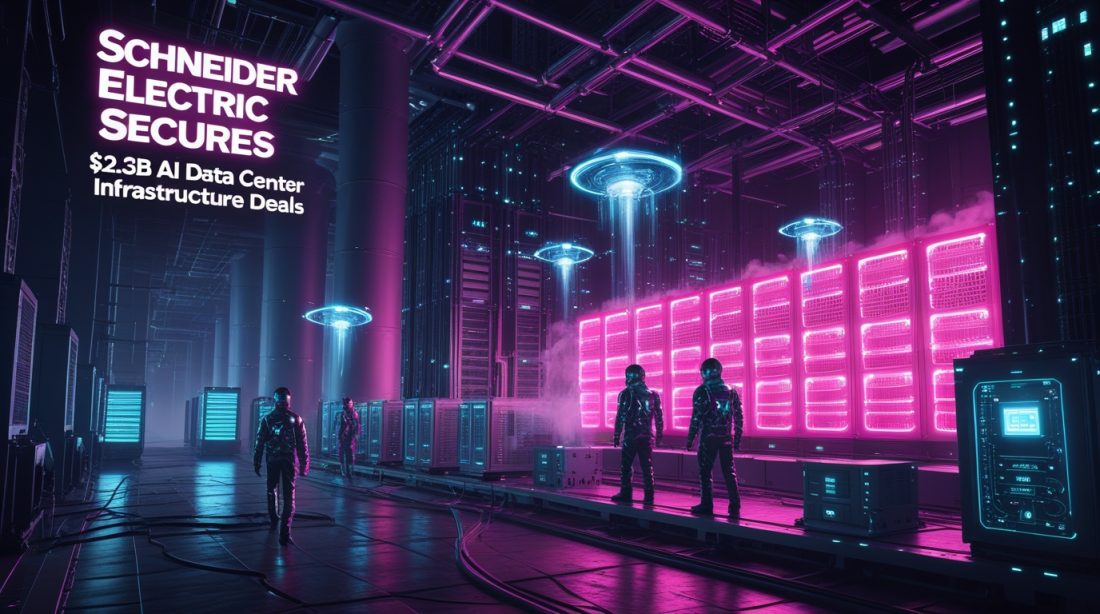Fast Facts
Schneider Electric secured nearly $2.3 billion in U.S. AI data center infrastructure contracts with Switch and Digital Realty, representing one of the largest North American cooling deployments to date. These agreements center on providing advanced power modules, cooling systems, and UPS solutions specifically engineered for AI workloads. The deals respond to unprecedented energy demands from AI infrastructure, with projections suggesting global data center power consumption could triple by 2030. This massive investment underscores a pivotal transition in industrial AI—where computational ambition meets physical infrastructure reality.
At a Glance: Schneider Electric’s Game-Changing AI Infrastructure Deals
| Deal Component | Switch Agreement | Digital Realty Agreement |
|---|---|---|
| Total Value | $1.9 billion | $373 million |
| Primary Focus | Cooling systems & power modules | UPS & low-voltage switchgear |
| Key Technologies | Uniflair chillers, prefabricated modules | Prefabricated power skids, dedicated production line |
| Industry Significance | Largest North American cooling services agreement | Supply Capacity Agreement model preserving vendor flexibility |
| Delivery Timeline | Phased delivery across 2025-2026 | Phased delivery across 2025-2026 |
Why $2.3 Billion in AI Data Center Deals Matters Now
Schneider Electric, France’s largest energy company by market value, announced nearly $2.3 billion in new agreements with two major U.S. data center operators at its Innovation Summit North America in Las Vegas. The timing is significant—with hyperscalers like Amazon, Meta, Google, and Microsoft projected to spend more than $360 billion on AI infrastructure in 2025 alone, the race to build computational capacity has created unprecedented demand for specialized physical infrastructure.
These deals represent more than just revenue for Schneider; they signal a fundamental shift in how industrial AI systems must be supported. “Current data center infrastructure wasn’t built to meet the demands of AI,” acknowledged Vandana Singh, senior vice president at Schneider’s North American secure power division . This admission underscores a critical reality: the AI revolution cannot advance without a parallel revolution in the physical infrastructure that powers and cools it.
Breaking Down the Major Deals: Where the Money Flows
The $1.9 Billion Switch Partnership: Cooling at Scale
Schneider’s agreement with privately-held Switch represents the company’s largest cooling services commitment for data centers in North America to date . The monumental deal focuses on providing prefabricated power modules and advanced cooling infrastructure, including the first U.S. deployment of Schneider’s Uniflair chillers .
This partnership directly addresses one of the most pressing challenges in AI infrastructure: removing heat from high-density computing environments. With AI server racks already exceeding 100 kW per rack—and projected to reach 1,000 kW by 2029—traditional cooling methods have become inadequate . The Switch agreement represents a massive scaling of specialized cooling solutions that can handle these intense thermal loads without proportionally increasing energy consumption.
The $373 Million Digital Realty Agreement: Power Reliability Redefined
The second agreement, with Texas-based Digital Realty, focuses on uninterruptible power supplies (UPS) and low-voltage switchgear. Valued at $373 million, this contract adopts an innovative Supply Capacity Agreement model that guarantees production capacity while preserving multi-vendor flexibility for Digital Realty.
For AI operations, power reliability isn’t merely convenient—it’s economically essential. Training complex AI models across thousands of GPUs requires days or weeks of continuous computation, where any power interruption can mean substantial financial losses and lost development time. Schneider’s power infrastructure ensures that these industrial AI operations can proceed without interruption, even as power grids face increasing strain from surging electricity demands.
Why Industrial AI Demands Specialized Power and Cooling
The Energy Intensity of AI Workloads
Industrial AI applications differ significantly from conventional computing tasks in their energy requirements. Where a traditional cloud data center might support various enterprise applications with moderate power needs, AI training clusters concentrate extraordinary computational power in dense configurations.
Morgan Stanley analysts estimate that global power demand from data centers will nearly triple in the next three years, intensifying strain on already stretched U.S. power grids .
The specialized hardware driving the AI revolution consumes power at an unprecedented scale. AI server racks filled with high-performance GPUs can draw as much power as dozens of conventional server racks. This density creates thermal challenges that conventional data center infrastructure simply cannot address, necessitating the specialized solutions that Schneider provides.
Beyond Hyperscale: The Industrial AI Applications at Stake
The infrastructure supported by these deals enables more than just consumer-facing AI chatbots. These facilities form the backbone of next-generation industrial applications:
- Manufacturing: AI-driven predictive maintenance and quality control systems
- Healthcare: Drug discovery and medical imaging analysis
- Autonomous Systems: Training and simulation for self-driving vehicles
- Scientific Research: Climate modeling and materials science
When an AI model used for factory predictive maintenance goes offline due to cooling failures, it doesn’t just inconvenience users—it halts production lines, wastes materials, and delays shipments. The reliability engineered into Schneider’s infrastructure therefore supports critical path industrial operations.
Technical Deep Dive: The AI-Ready Infrastructure Solutions
Advanced Cooling Architectures
Schneider’s solution for Switch represents a fundamental shift from room-level cooling to direct component-level heat removal. The deployment of Uniflair chillers and other advanced cooling technologies enables far more efficient thermal management for high-density AI racks .
The agreement includes “the first national deployment of Schneider Electric’s Uniflair chillers,” representing a significant technological advancement in data center cooling infrastructure .
These systems are essential because AI chips can generate 2-3 times more heat than traditional processors while being more sensitive to temperature fluctuations. Precision cooling maintains optimal operating conditions, preventing thermal throttling that can degrade AI training performance by 20% or more.
Power Management Innovations
For the Digital Realty agreement, Schneider provides UPS systems and low-voltage switchgear specifically designed for AI’s unique power characteristics . AI workloads create what engineers call “power transients“—rapid, unpredictable spikes in electricity consumption as different computational phases activate .
Traditional power infrastructure struggles with these patterns, but Schneider’s solutions provide clean, stable power regardless of load fluctuations. Their approach includes prefabricated power skids that are factory-built and tested before shipment to data center sites, reducing deployment time and improving reliability .
The Broader Market Context: $1 Trillion Infrastructure Spending
Projected Infrastructure Investment
Schneider’s deals occur against a backdrop of unprecedented data center infrastructure investment. According to IoT Analytics, global spending on data center equipment and infrastructure is headed toward $1 trillion by 2030, up from $290 billion in 2024 .
This spending is distributed across two primary categories:
| Infrastructure Category | Share of 2024 Spending | Key Growth Drivers |
|---|---|---|
| IT Infrastructure | 78% | AI servers, networking for AI clusters, specialized storage |
| Facility Infrastructure | 12% | High-density power systems, advanced cooling, grid integration |
The Competitive Landscape
Schneider Electric operates in a competitive but expanding market. Key competitors include:
- Vertiv Holdings: Recently reported 35% sales growth, with partnership connections to NVIDIA
- Eaton: Another major player in power management solutions for data centers
- ABB: An early innovator in medium-voltage power architecture for data centers
What distinguishes Schneider’s position is its comprehensive portfolio spanning both power and cooling solutions, coupled with its vertical integration strategy. The company has emerged as a key data center supplier, making server racks, cooling and power equipment that form the backbone of AI infrastructure .
The Strategic Outlook: What These Deals Signal for AI’s Future
Addressing the Energy Dilemma
The scale of Schneider’s agreements highlights the central paradox of AI advancement: as models become more capable, they demand more energy, yet their development is constrained by practical energy limitations. Schneider’s solutions aim to scale AI capacity without proportional increases in energy demand .
This efficiency is crucial not just for operational economics but for environmental sustainability. Internal projections at Schneider indicate artificial intelligence could account for over 35% of global data center workloads by 2030, potentially driving a 160% increase in energy consumption at these facilities .
The Infrastructure-as-Strategy Imperative
For industrial companies pursuing AI strategies, these deals underscore that computational ambition must be matched by infrastructure investment. The companies succeeding with industrial AI will be those that recognize AI infrastructure as strategic capability, not just technical overhead.
Schneider’s spokesperson noted that “the two contracts are a phased delivery of 2025 and 2026” , indicating that major data center operators are planning years ahead for AI infrastructure needs rather than reacting to immediate demands.
Beyond the Headlines – Infrastructure as AI Enabler
Schneider Electric’s $2.3 billion in data center deals represents more than commercial success—it signals a fundamental reordering of priorities in the AI ecosystem. Computational potential is now constrained by physical infrastructure realities, making companies like Schneider critical enablers of AI progress.
For industrial enterprises, the implication is clear: AI strategy must encompass infrastructure strategy. The algorithms that optimize supply chains, streamline manufacturing, and accelerate research depend entirely on the power and cooling systems that make computation possible. As Schneider demonstrates through these historic agreements, supporting AI’s future requires building its physical foundation today.
Subscribe to our newsletter for more expert analysis of industrial AI infrastructure trends and developments.
> CreedTec: Powering Industrial Transformation Through Intelligent Infrastructure
Further Reading
- ARM Architecture for Industrial AI Revenue → Connects hardware design to industrial AI growth, complementing Schneider’s cooling/power infrastructure angle.
- TSMC 2025 Revenue Forecast Surges Again: AI Chip Demand Is Breaking Every Record → Shows how chip demand drives the need for massive AI data center infrastructure.
- Predictive Maintenance for Nigerian SMEs → Links Schneider’s industrial AI infrastructure to practical factory applications in emerging markets.
- SymphonyAI Iris Forge: The Fast-Deploy Industrial AI Platform Explained → Highlights rapid deployment platforms that rely on robust infrastructure like Schneider’s.
- The Rise of the Industrial AI Data Marketplace → Explores how industrial AI infrastructure enables new data-driven marketplaces.


